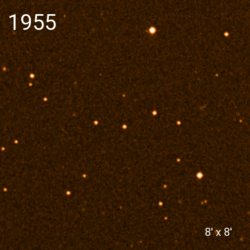Astronomy:LP 40-365
From HandWiki
Short description: Star in the constellation Ursa Minor
Coordinates: ![]() 14h 6m 35.45s, +74° 18′ 58″
14h 6m 35.45s, +74° 18′ 58″
 Tangential movement of LP 40-365 between 1955 and 1995. The field of view is 8 × 8 arcminutes. Credit: Digitized Sky Survey | |
| Observation data Equinox J2000.0]] (ICRS) | |
|---|---|
| Constellation | Ursa Minor |
| Right ascension | 14h 06m 35.45s[1] |
| Declination | +74° 18′ 58.0″[1] |
| Apparent magnitude (V) | 15.51 ± 0.09[2] |
| Characteristics | |
| Spectral type | D[2] |
| Astrometry | |
| Radial velocity (Rv) | 498[2] km/s |
| Total velocity | ~546[2] km/s |
| Proper motion (μ) | RA: −56 ± 7[2] mas/yr Dec.: 148 ± 7[2] mas/yr |
| Distance | 632[3] pc |
| Absolute magnitude (MV) | 8.14+0.60 −0.90[2] |
| Details[2] | |
| Mass | 0.14 ± 0.01 M☉ |
| Radius | 0.078+0.040 −0.020 R☉ |
| Surface gravity (log g) | 5.80+0.20 −0.35 cgs |
| Temperature | 10100+250 −350 K |
| Rotational velocity (v sin i) | 30.5 ± 2.0 km/s |
| Other designations | |
| Database references | |
| SIMBAD | data |
LP 40-365 is a low-mass white dwarf star in the constellation Ursa Minor. It travels at high speed through the Milky Way and has a very unusual elemental composition, lacking hydrogen, helium or carbon. It may have been produced in a subluminous Type Iax supernova that failed to destroy its host star totally.[2] [4][5] The "LP" name is derived from the Luyten-Palomar proper motion catalogue in which it appeared in the 1960s.[6] Another catalog name for this star is "GD 492". [3] The star was cataloged as a Giclas object with the designation "GD 492" being assigned by Henry Giclas in 1970.[7]
References
- ↑ 1.0 1.1 Cutri, Roc M.; Skrutskie, Michael F.; Van Dyk, Schuyler D.; Beichman, Charles A.; Carpenter, John M.; Chester, Thomas; Cambresy, Laurent; Evans, Tracey E. et al. (2003). "VizieR Online Data Catalog: 2MASS All-Sky Catalog of Point Sources (Cutri+ 2003)". CDS/ADC Collection of Electronic Catalogues 2246: II/246. Bibcode: 2003yCat.2246....0C. http://vizier.u-strasbg.fr/viz-bin/VizieR?-source=II/246.
- ↑ 2.0 2.1 2.2 2.3 2.4 2.5 2.6 2.7 2.8 Vennes, Stephane; Nemeth, Peter; Kawka, Adela; Thorstensen, John R.; Khalack, Viktor; Ferrario, Lilia; Alper, Erek H. (18 August 2017). "An unusual white dwarf star may be a surviving remnant of a subluminous Type Ia supernova". Science 357 (6352): 680–683. doi:10.1126/science.aam8378. PMID 28818942. Bibcode: 2017Sci...357..680V.
- ↑ 3.0 3.1 3.2 "GD 492". SIMBAD. Centre de données astronomiques de Strasbourg. http://simbad.u-strasbg.fr/simbad/sim-basic?Ident=GD+492.
- ↑ "Science Press Release". https://astroserver.org/references/NWKZKA/.
- ↑ Javier Barbuzano (17 August 2017). "The White Dwarf That Survived". Sky & Telescope. http://www.skyandtelescope.com/astronomy-news/white-dwarf-survived-supernova/.
- ↑ Luyten, W. J. (1963–1981). "Proper Motion Survey with the 48 inch Schmidt Telescope". University of Minnesota.
- ↑ Giclas, Henry L.; Burnham, Robert; Thomas, Norman Gene (1970). "A list of white dwarf suspects III : Special objects of small proper motion from the Lowell survey" (in en). Bulletin of the Lowell Observatory 7 (153): 183. Bibcode: 1970LowOB...7..183G.
External links
 |

